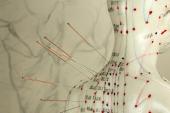Chinese Medicine Tongxinluo Yields ‘Surprising’ Benefits Post-STEMI: CTS-AMI
The large, multicenter trial saw dramatic drops in death and MI, but some query the compound ingredients and reproducibility.

CHICAGO, IL—It’s not clear what aspect of the CTS-AMI trial raised more eyebrows at the American Heart Association (AHA) 2022 Scientific Sessions: the dramatically positive effects of a traditional Chinese medicine in reducing 30-day events post-STEMI or the components of the agent itself. The compound, tongxinluo, contains seven different plants plus cockroach, scorpion, cicada, centipede, and leech.
Tongxinluo (Yiling Pharmacological) has been approved for the treatment of angina and stroke in China since 1996, but as CTS-AMI investigator Yuejin Yang MD, PhD (Fuwai Hospital of CAMS & PUMC, National Center for Cardiovascular Diseases, Beijing, China), explained during his late-breaking presentation at AHA, preclinical studies have also suggested that the compound reduces myocardial no-reflow and infarct size following reperfusion, and protects endothelium and microvasculature to forestall reperfusion injury.
That may be particularly important for STEMI patients in rural China, he said, where delays to timely reperfusion mean that many patients are left with substantial infarct sizes.
The China Tongxinluo Study for Myocardial Protection in Acute MI (CTS-AMI) enrolled 3,797 patients at 124 hospitals across China, ultimately randomizing 1,874 patients to tongxinluo and 1,881 patients to a placebo specially designed by the study sponsor to have the same appearance, odor, and taste as the study drug.
Listening in the audience was like, wow, really? That sounds interesting, tell me more. Dipti Itchhaporia
Tongxinluo and placebo were given as a loading dose of 2.08 g (eight capsules) followed by a maintenance dose of 1.04 g (four capsules) three times a day for 12 months on top of guideline-directed therapy.
Nearly half of the STEMI patients in both arms were smokers, half had hypertension, nearly one-quarter had hyperlipidemia, and 77% were male. Of note, symptom-to-balloon time for the 93-94% of patients who underwent primary PCI was nearly 6 hours in both arms.
At 30 days, the rate of major adverse cardiovascular or cerebrovascular events (MACCE), the study’s primary endpoint, was 3.39% in the tongxinluo group as compared with 5.24% in the placebo group, a relative risk reduction of 36% (RR 0.64; 95% CI 0.47-0.88).
Cardiac death at 30 days, a secondary endpoint, was 30% lower in the tongxinluo patients than in placebo-treated patients (2.97% vs 4.24%; RR 0.70; 95% CI: 0.50-0.99), and while no repeat MI occurred in the tongxinluo group, nine MIs occurred in the placebo arm (RR 0.35; 95% CI: 0.13-0.99). All of the subgroups analyzed appeared to derive benefit from the study drug, and serious adverse event rates were similar in both groups, in the range of 2-3%.
At 1 year, rates of MACCE, cardiac death, repeat MI, and stroke were also significantly—and in some cases, dramatically—reduced in patients randomized to tongxinluo.
“Tongxinluo, a traditional Chinese medicine, significantly improves both the 30-day and 1-year clinical outcomes of Chinese patients with STEMI, especially reducing cardiac death and severe complications, [and] did not result in severe side effects such as major bleeding,” Yang concluded. “These findings support the use of tongxinluo as an adjunct therapy in treating STEMI, at least in China and other developing countries.”
Mixed Reactions
Reaction from experts at AHA seemed to be a mix of admiration and bewilderment at the magnitude of the effects for an agent they’d likely never previously heard of. Kenneth Mahaffey, MD (Stanford University, CA), the scheduled discussant following Yang’s presentation, noted that there are multiple proposed mechanisms for the benefits on no-reflow, reperfusion injury, and endothelial function, but the 30% reduction in cardiovascular deaths stands out as “interesting,” he said.
“As we evaluate and reflect on these initial results, I think that more details about the analysis, trial conduct, and the potential mechanisms will be informative,” Mahaffey said. “This will include the results by any intention-to-treat analyses, the methods used to ascertain and define the nonfatal endpoints, given the very small numbers, and then any information about the use of evidence-based therapy—anticoagulation, statins, beta-blockers, ACE inhibitors, and ARBs.”
Further analyses of angiograms, serial echocardiography, and biomarkers collected will hopefully provide “potential elucidation of the mechanisms,” he continued. “With the results so far as we await additional data, I believe that for now, these results will likely support the use of this traditional Chinese medicine in ST-elevation MI patients in China. More studies are needed in other populations and treatment paradigms,” Mahaffey concluded.
Others who spoke with TCTMD raised many of the same questions—what did guideline-directed therapy entail for this Chinese cohort, how were events ascertained during follow-up, what were the side effects, if any, and what was patient adherence to what was a high additional pill burden over 12 months of follow-up?
We in the West do tend to have a much more skeptical attitude to traditional Chinese medicines (TCM) than the Chinese do. Albert Ferro
“It's intriguing,” Dipti Itchhaporia, MD (Hoag Memorial Hospital Presbyterian, Newport Beach, CA), immediate past president of the American College of Cardiology, told TCTMD. “The magnitude of the effect seems surprising, and so I guess I'm going to hold off my excitement until I know if we can reproduce this in different sites.”
That said, she acknowledged there is a lot still unknown in STEMI care, offering the example of acute coronary syndromes in women without obstructive coronary disease. “There are clearly other things that we don't really have a good understanding about and so maybe these types of drugs are going after endothelial and microvascular dysfunction, other things we don't understand,” Itchhaporia noted.
But that’s where better delineation of the mechanism will be key, as well as a better understanding of the compound itself. “Listening in the audience was like, wow, really? That sounds interesting, tell me more,” said Itchhaporia. “But I think we need to get more evidence that this works: I'd love to see this trial being done in Europe or the US, other populations," many of whom might balk if they learned what was in the medication, she agreed. "I sort of got stuck when I heard the word 'insects.'"
That impulse to better appreciate the compound and mechanism of action does speak to a Western bias against Traditional Chinese Medicine (TCM), said Albert Ferro, MBBS, PhD (King’s College London, England), a professor of cardiovascular clinical pharmacology who reviewed the study for TCTMD.
“We in the West do tend to have a much more skeptical attitude to TCM than the Chinese do. They learn about traditional medicines and Western medicine in parallel and they practice both, and they don't really have an issue with that at all, whereas we do tend to focus on the fact that a lot of these things aren't well validated scientifically. We don't know what the active moiety is. It's all a mixture, here, of herbs and insects, and what is it in all of that that's doing the good stuff?” he said. “We do have that intrinsic bias, in the West, when we're presented with TCMs.”
But Ferro, too, raised many of the same questions as Mahaffey and Itchhaporia about the study design and findings, saying he would want to see the study replicated in other populations, with a better understanding of the background drugs being taken.
“We do want to know more about [whether] this a real effect,” he said. “If it is a real effect, what is it in there that's causing it? And I think there is also the magnitude of the effect, which is just out of proportion really to what to virtually anything else we've seen in recent years.”
But for anyone caught up in elements of CTS-AMI, or Chinese STEMI care more broadly, that struck them as inferior or unorthodox, Mahaffey offered a reminder: “Despite being [conducted] in rural China,” he observed following Yang’s presentation, “over 90% of people had coronary angiography and 87% of patients had reperfusion therapy, driven primarily by PCI.”
Shelley Wood is the Editor-in-Chief of TCTMD and the Editorial Director at CRF. She did her undergraduate degree at McGill…
Read Full BioSources
Yang Y. The impact of Chinese herbal medicine tongxinluo in patients with acute myocardial infarction: results from the CTS-AMI trial. Presented at AHA 2022. November 6, 2022. Chicago, IL.
Disclosures
- The CTS-AMI trial was funded by the National Key Research and Development Program of China, with Tongxinluo and placebo provided by Yiling Pharmacological.
- Ying reports having no relevant financial conflicts.
- Mahaffey reports receiving research funding from AHA, Apple, Bayer, CIRM, Eidos, Ferring, Gilead, Idorsia, J&J, Luitpold, PAC-12, Precordior, Sanifit, and Verily (Google); consulting fees from Amgen, Applied Therapuetics, AZ, Bayer, CSL Behring, Elsevier, Fibrogen, Inova, J&J, Lexicon, Moderna, Myokardia, Novartis, Novo Nordisk, Otsuka, Phasebio, Portola, Quidel, Sanofi, and Theravance; and having equity with Precordior.
- Ferro and Itchhaporia report having no relevant COI.




Comments